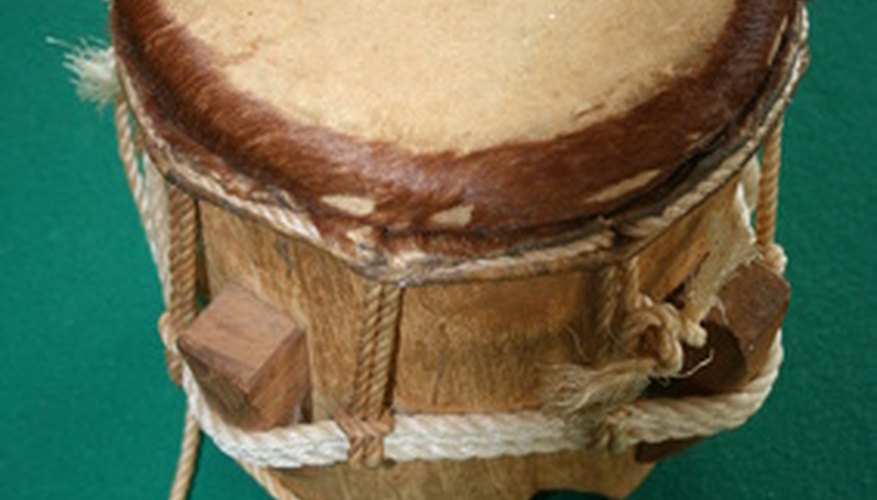Since ancient times, percussion instruments have been an important part of traditional British folk music. Metal, bones, animal hides and wood produced rhythmic sounds by being shaken, vibrated, or hit with the hand or a tool.
Beginning early in the 17th century, the term percussion instrument referred to either idiophones, such as rattles and bells, and membranophones, such as drums. Percussion instruments were handcrafted for religious ceremonies, entertainment and celebrations.
Bones
A pair of cow ribs rattled together in the hand has long been a traditional percussion instrument in Britain. In ancient times, cow bones were associated with daily life and local celebrations and festivals. Shakespeare mentioned them in "A Midsummer Night's Dream" in the late 1500s. In the 17th century, bones were called "knicky-knackers" in Britain, and are still a recognised form of music in English pubs and at traditional weddings. To play this instrument, two bones are held loosely in one hand, which is then shaken in rhythm to produce sharp, clacking sounds.
- A pair of cow ribs rattled together in the hand has long been a traditional percussion instrument in Britain.
- In the 17th century, bones were called "knicky-knackers" in Britain, and are still a recognised form of music in English pubs and at traditional weddings.
The Tabor
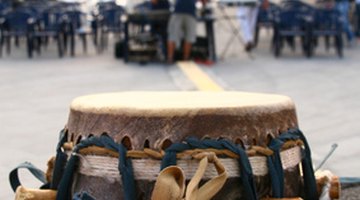
A tabor is a medieval version of a snare drum. In Britain, the tabor was made of a circular wooden shell, with animal skins tightened by rope tension to create a head on both sides. It was suspended mid-arm by a leather strap, and a gut snare was sometimes stretched across the upper drum head. Unlike modern snare drums, only one shaped stick was used to sound a tabor. This small drum was occasionally accompanied by a small flute wielded by the drummer's other hand, possibly coining the term "One Man Band."
- A tabor is a medieval version of a snare drum.
- In Britain, the tabor was made of a circular wooden shell, with animal skins tightened by rope tension to create a head on both sides.
The Triangle
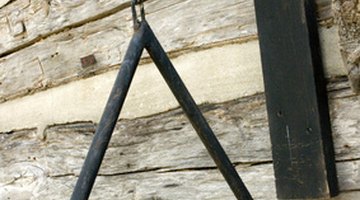
The triangle is classified as a idiophone percussion instrument, according to Medieval Life and Times. Introduced into Britain during the 14th Century, this instrument was, and is, a simple metal bar bent into a triangle with one open angle. A metallic, bell-like tone is produced by striking the triangle with a metal rod. The sound produced can vary depending on where the triangle is struck.
- The triangle is classified as a idiophone percussion instrument, according to Medieval Life and Times.
- A metallic, bell-like tone is produced by striking the triangle with a metal rod.
Cymbals
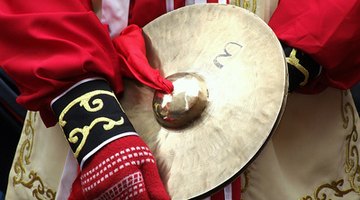
Cymbals are thin, round, concave metal plates in varying sizes with handles centred on the back of each plate. Small finger cymbals were an integral part of medieval British folk music, according to Iowa State University. The word cymbal means "small bowl" translated from cymbalum in Latin. Cymbals are played by clashing two together to produce loud ringing sounds. The tone of the cymbals depends on the size of the plates.
- Cymbals are thin, round, concave metal plates in varying sizes with handles centred on the back of each plate.
Timbrel
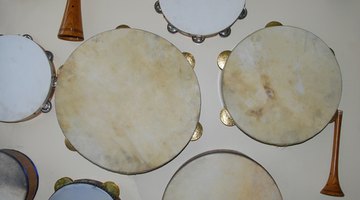
The timbrel, or tambourine, is a wood-framed drum with a single head made of animal hide or parchment. The frame, or shell, was originally hung with loosely attached pairs of small bells or metal discs called zils. It was widely used during the Middle Ages in British traditional music after being introduced to that country during the crusades. The English renamed the instrument tambourine in reference to it's drum head. The design of the classic timbrel has changed little through the ages.
- The timbrel, or tambourine, is a wood-framed drum with a single head made of animal hide or parchment.
Bells
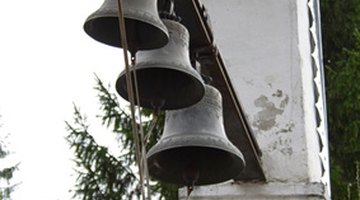
While bells were often associated with religious ceremonies and rites in early Britain, several types were also used as traditional folk percussion instruments. Cow bells, hand bells, and jingle bells were used by musicians, and various sized bells were often permanently strung in areas of feasting and celebration. A bell ringer was a person designated to ring either a church bell or chime, or a set of musical bells for public entertainment.
The Jew's Harp

The earliest known written reference to a Jew's harp in Britain was in 1595, although possibly the first image of this instrument was found carved on the official staff of William of Wickham in Oxford, dated to approximately 1390. Jews Harper reports the original term may have been "gewgaw," a medieval English word for a small musical instrument, trinket or bauble. The Jew's Harp is classified as a percussion instrument in the category of plucked idiophones
- The earliest known written reference to a Jew's harp in Britain was in 1595, although possibly the first image of this instrument was found carved on the official staff of William of Wickham in Oxford, dated to approximately 1390.
It is played by holding the wooden frame against the front teeth while plucking the metal or wood tongue or reed. The pitch and tone of the notes are controlled by changing the shape of one's mouth, and volume is changed by breathing in and out.
